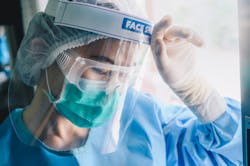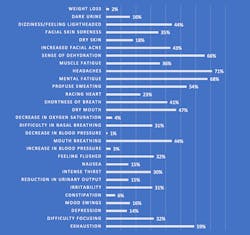Headaches, exhaustion, anxiety: The physical and emotional challenges of returning to work during the pandemic
The recent disruption in health care delivery took all of North America by surprise. No one anticipated a three-month slowdown for all but the most essential dental care. Few were fully prepared to reenter their dental office doing business as usual. Yes, most practices have worked diligently to comply with the existing OSHA regulations and CDC recommendations. It’s been daunting to keep up with the daily changes and the individual state mandates. How we practiced at the end of the last millennium is simply unthinkable to most six months later.
The recent disruption in health care delivery took all of North America by surprise. No one anticipated a three-month slowdown for all but the most essential dental care. Few were fully prepared to reenter their dental office doing business as usual. Yes, most practices have worked diligently to comply with the existing OSHA regulations and CDC recommendations. It’s been daunting to keep up with the daily changes and the individual state mandates. How we practiced at the end of the last millennium is simply unthinkable to most six months later.
In grad school, I became fascinated with data. From a public health perspective, the workforce is a critical component. Quality care simply can’t be delivered without educated workers. My thesis research revealed an important piece of data, clinical dental hygienists wanted to know their voices are being heard. This basic piece of information has simply not changed. We still want to be heard.
The conversation
Dental professionals everywhere are concerned about their own safety and well-being, and also the safety of patients and coworkers. Countless dental professionals have been expressing concern about how they were going to be able to work with the new personal protective equipment (PPE) recommendations. Practices and clinicians have spent hours and thousands of dollars on equipment and supplies.
Over the past few weeks, reports started coming in from those who had already started providing emergency care. Clinicians were reporting profuse sweating, headaches, and fatigue. There have always been thermostat wars, but these conversations were different. Clinicians who love treating patients started to worry.
Something was going on. My nerd gene kicked in. I scoured PubMed for research about the impact of PPE on health-care providers. There were a few old studies and a handful have been posted since the start of 2020, but there was simply not enough to satisfy my curiosity. We need data, and we need data about all dental health-care workers.
As the conversations grew, it was clear that dental professionals may face multiple health challenges as we adopt new ways of practicing. Will some problems be temporary, and others more complicated with unexpected consequences? These questions simply can’t be answered right now, but our mindset has to shift. We need to learn to prepare for our health in a different way to protect our physical and emotional well-being.
Data collection
As the dental community moves forward, it is critical that we collect data. My initial goal was to query dental professionals on what is known as dehydration headaches, but as the search grew deeper, it became apparent that clinicians are facing a huge seismic shift in how we deliver care.
At 4 pm on Monday, June 8, 2020, I posted an eight-question convenience poll on multiple social media sites, and in minutes, data started rolling in. In less than two days nearly 2,529 hygienists, dentists, assistants, and business administrators answered. Most are back in the clinical setting. Their thoughts and experiences were captured, providing a snapshot of what all dental health care workers are facing as we go back to work. For those back in active practice, that wish to participate, the survey is can be found here.
Preliminary findings
There is no way to forecast how the future health of dental health-care workers will fare, but without information, we simply won’t know what questions to ask, much less how to adapt. Here is some of the raw data.
- 92% respondents - dental hygienists, Remaining 8% – dentists, assistants, business staff
- Respondent ages – 20’s=318, 30’s=736, 40’s=684, 50’s=565, 60’s=207
- Pre-COVID headache - 16% headaches weekly or daily
- Current headache rate – 65% increased headache frequency
- Hard to breathe - current respiratory PPE – 49% all of the time, 40% occasionally hard
- Wide adoption - combination PPE: face shields/respirators/double masking
The elephant in the room
One question generated an enormous response: Since using the new PPE in the clinical setting I am now experiencing the following conditions. (Check all that apply). The responses will make you realize you are not the only one.
Workers also reported experiencing dry eyes, sore throat, rash, runny nose, pressure blister on nose bridge, coughing at night, TMJ discomfort, eyestrain, tight chest, chapped lips, ear pressure, occlusion changes, clogged ears, bloating, itchy tingling skin, bloody nose, intermittent PVCs, facial muscle twitches, and sleep apnea.
What’s the plan?
While it is impossible to demonstrate causality with data from a convenience poll like this, the information clearly indicates that dental professionals of all ages are experiencing increased levels of physical and emotional discomfort as they transition back into the workplace.
Each one of us that holds a license pledged to do no harm when providing patient care. But can you honestly say that you would want to receive care from a clinician who has a raging headache, or is feeling exhausted? I am not advocating that we abandon our chosen professions at all, but rather asking you to spend time honestly assessing what is going on in your body and then formulating a plan on how to prepare for the workplace differently.
Every one of us will have to find their own personal oasis, but here are some potential questions to ponder. What are you willing to add, subtract, or simply tweak slightly?
- Plan for hydration breaks?
- Schedule an actual lunch hour?
- Take a PPE break?
- Alter your diet to include more liquids, fruits, and vegetables?
- Move on to a happier environment?
- Limit moisture-robbing, salty snacks?
- Create a personal, oral moisturizing plan?
- Learn to do nasal breathing?
- Speak your mind?
- Find a way to lower stress?
- Delegate household responsibilities?
- Let others take more responsibility?
- Stand up for yourself?
Once you’ve come up with some answers, set up a meeting with your doctor. Engage your employers and co-workers in finding workable solutions. Be the leader in bringing up these really hard subjects. Remember you’re not the only one who is hot and sweaty and trying to figure out “what next?” We can’t do this alone. We need each other.
Over the next few weeks and months, I will share more data and strategies on how we can survive and thrive our transition into the future.
Anne Nugent Guignon, MPH, RDH, CSP, provides popular programs, including topics on biofilms, power driven scaling, ergonomics, hypersensitivity, and remineralization. Recipient of the 2004 Mentor of the Year Award and the 2009 ADHA Irene Newman Award, Anne has practiced clinical dental hygiene in Houston since 1971, and can be contacted at [email protected].
About the Author

Anne Nugent Guignon, MPH, RDH, CSP
ANNE NUGENT GUIGNON, MPH, RDH, CSP, a visionary thinker, has received numerous accolades over four decades for mentoring, research, and guiding her profession. As an international speaker and prolific author, Anne focuses is on the oral microbiome, erosion, hypersensitivity, salivary dysfunction, ergonomics, and employee law issues. She may be contacted at [email protected].
Updated June 26, 2020

